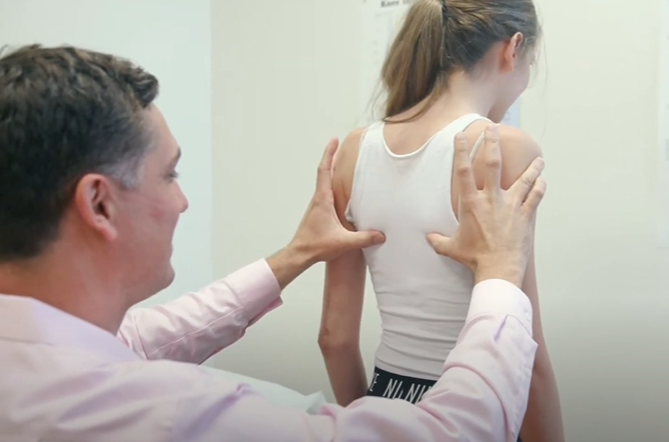
TYPES OF SCOLIOSIS
There are three types of scoliosis that can be diagnosed in children and adolescents. Treatment options vary depending on the patient’s type of scoliosis, its severity, and curve progression.
- Idiopathic scoliosis: This is the most common type of scoliosis making up 80-85% of cases. The cause of idiopathic scoliosis is unknown, but research has shown genetics play a role in around 30% of patients. Treatment for idiopathic scoliosis generally begins when small curves are first detected in a child’s spine around the age of 10 and up to when he/she is fully grown.
There are two other types of scoliosis that are less common; congenital and neuromuscular.
- Congenital scoliosis: This type occurs if a baby’s spine did not fully form, or if it fused together before birth. Because abnormalities are present at birth, congenital scoliosis is usually diagnosed at a younger age than idiopathic scoliosis.
- Neuromuscular scoliosis: This type of scoliosis can occur in a patient diagnosed with a condition that affects the nerves and muscles. Conditions such as muscular dystrophy or cerebral palsy can cause imbalance and weakness in the muscles that support that spine, leading to scoliosis.
SIGNS AND SYMPTOMS OF SCOLIOSIS
There are several symptoms that may indicate scoliosis. If one or more of these signs are noticed, schedule an appointment with your provider.
- Uneven shoulders
- One shoulder blade that is more prominent than the other
- One or both hips appear raised or unusually high
- Uneven waist
- Head does not appear centered with the rest of the body
- Asymmetric ribcage
TREATMENT OPTIONS FOR SCOLIOSIS
Non-surgical treatment
When treating scoliosis, there are both surgical and non-surgical options, depending on the patient’s individual case. Children with mild scoliosis typically do not require any treatment and will be monitored closely every four to six months for changes in the curvature of their spine. Bracing is a nonsurgical treatment option that is used to keep the curve from getting larger as the patient’s spine grows. Typically, one out of every six patients show signs of their curve enlarging during a growth spurt. If a patient is showing signs of curve growth, bracing can help keep the spinal curve from growing large enough to require surgery.
Surgical Treatment
If it is determined that surgery is needed, a spinal fusion is performed, which realigns and fuses together the curved vertebrae with the intention of them healing into a single, solid bone. Surgeons today are also able to straighten the curve as far as is safe, improving the outward physical appearance of the curve. Surgery is showing to be very successful in halting curve growth and reducing the severity of a curve.
Experts continue to research scoliosis and its effective treatment options, including Dr. Justin Roth, pediatric orthopedic surgeon for The Center Orthopedics & Neurosurgical Care & Research. Dr. Roth recently presented his research on proximal junctional kyphosis, a poorly understood complication that can develop in adolescents after scoliosis surgery. “It was an honor to be selected as an expert in the field and to present the scoliosis research I conducted with my colleague, Dr. Scott Luhmann, from Washington University in St. Louis, and Shriner’s Hospital in St. Louis,” said Dr. Roth. “Sagittal plane deformity has been a hot topic in scoliosis research for the last few years as we work to understand and minimize the complication of proximal junctional kyphosis. The research provided valuable insight for other providers caring for adolescent patients with scoliosis all over the world.
There is currently no evidence that alternative scoliosis treatment options have any long term impact on scoliosis curves. Alternative treatments can include; physical therapy, chiropractic treatment, acupuncture, yoga, massage, Pilates, electrical stimulation, etc. While some of these options can help build strength or help with back pain, you should speak with your spinal orthopedist or neurosurgeon about what option(s) may help supplement your treatment plan.





